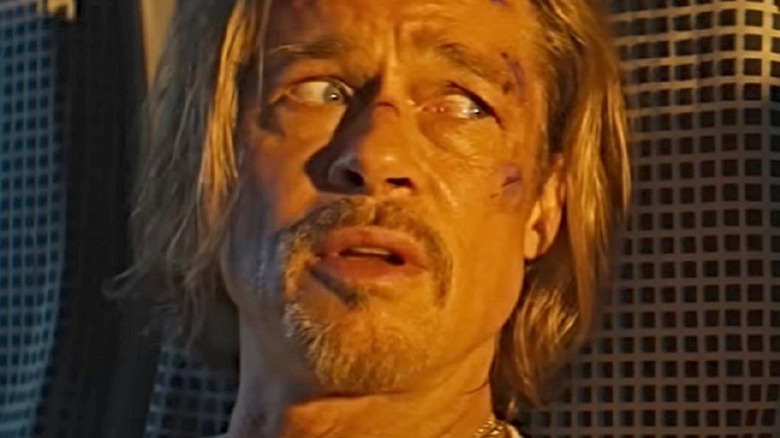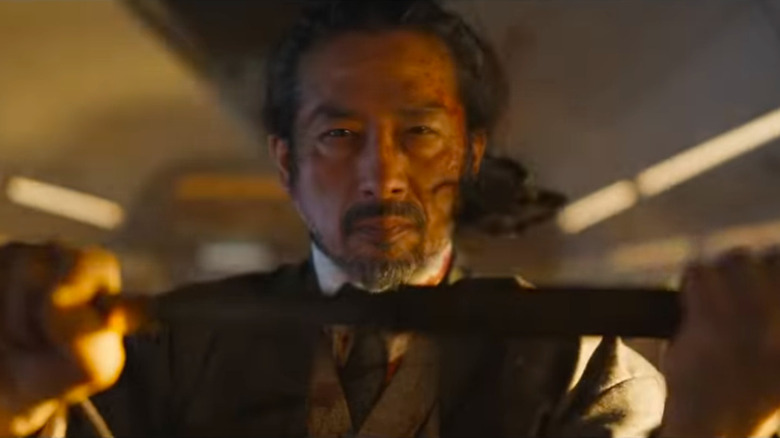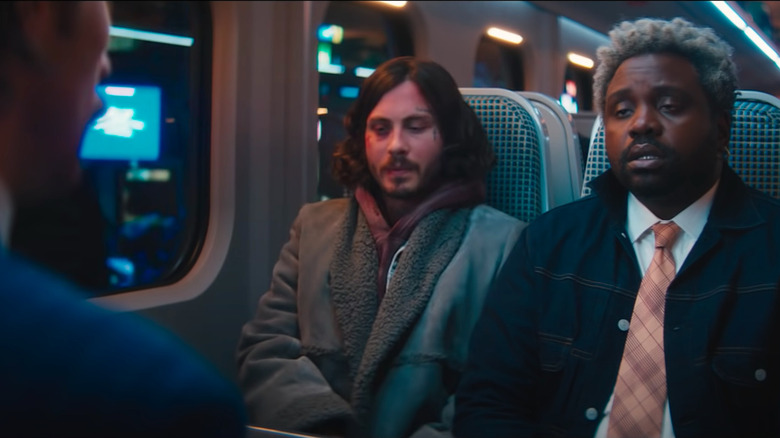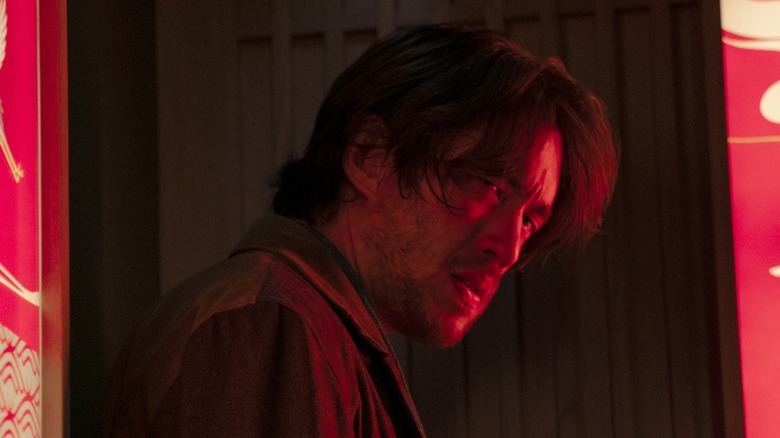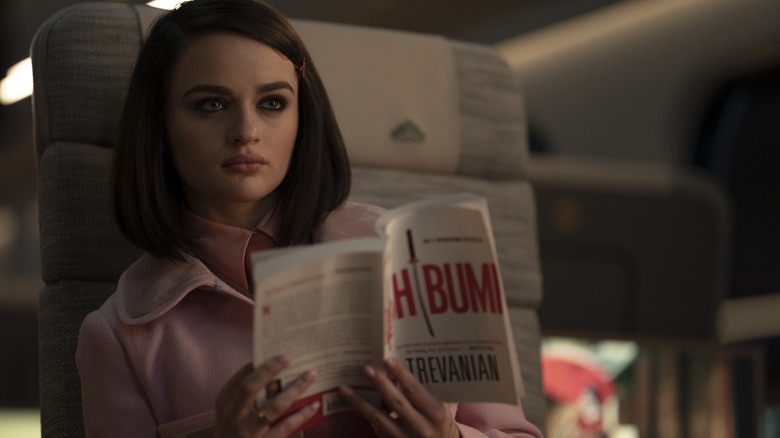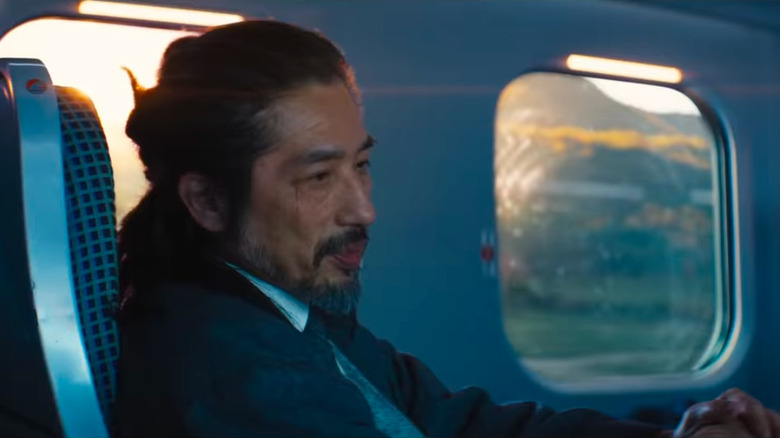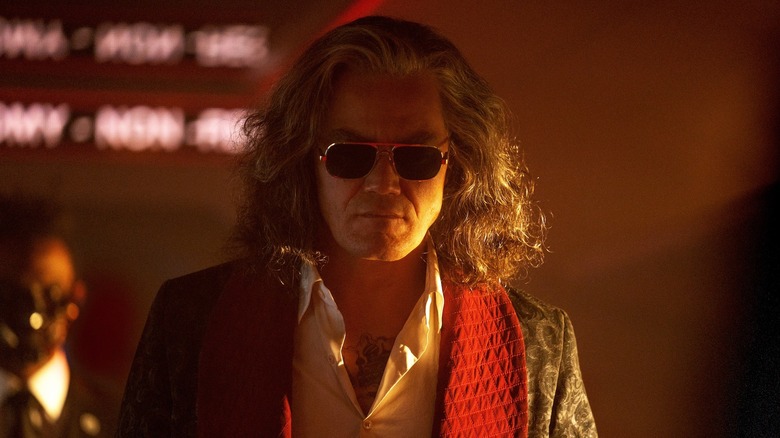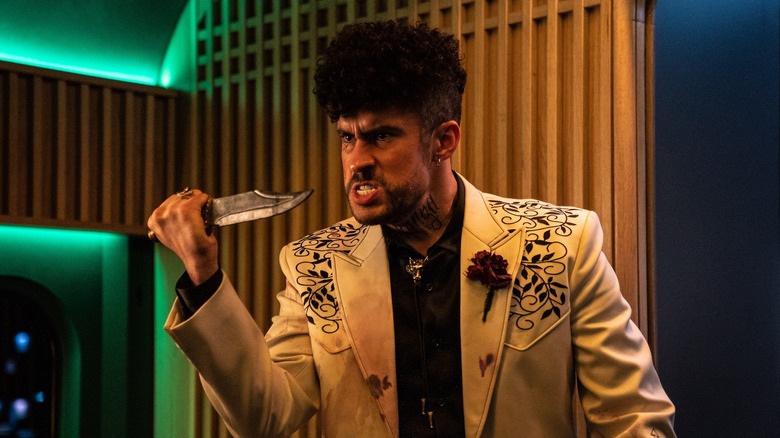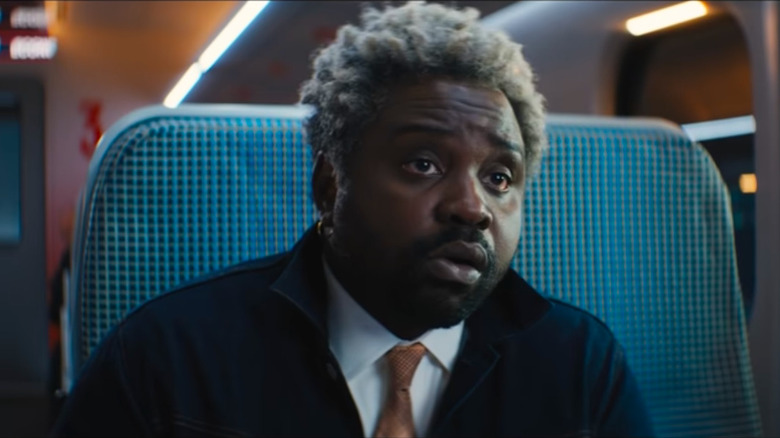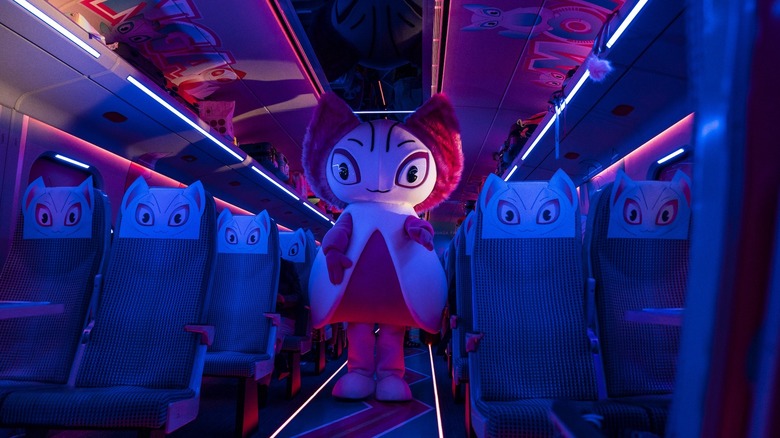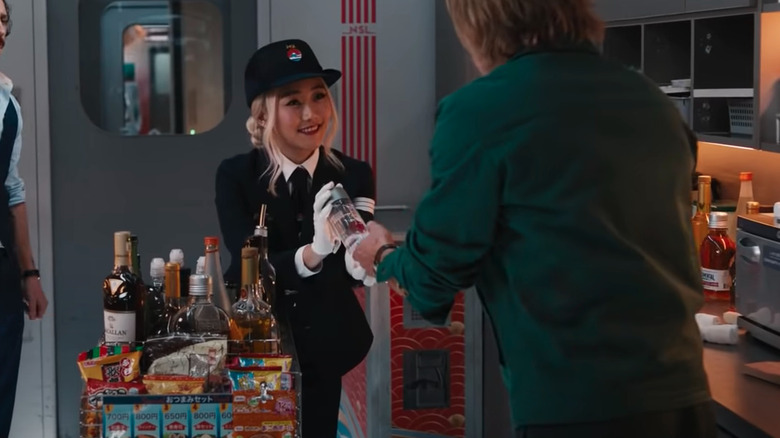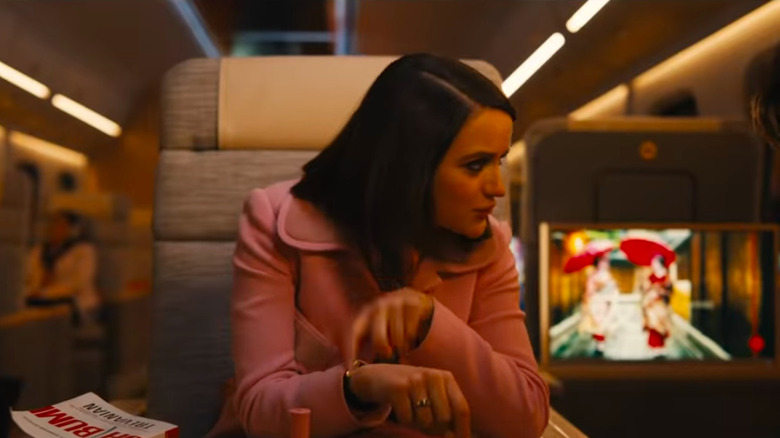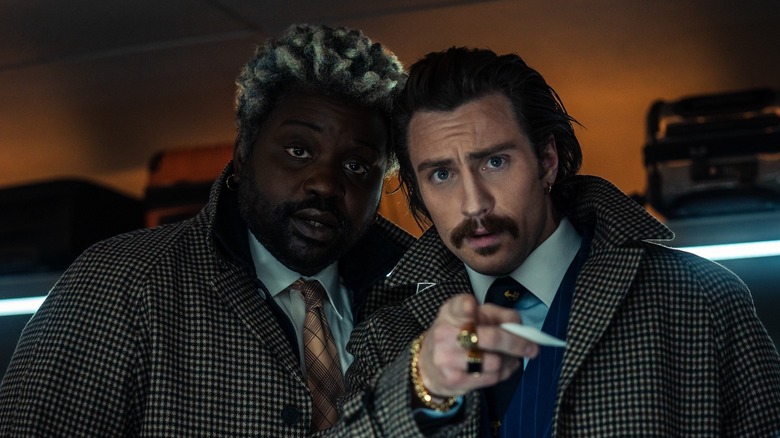Small Details You Missed In Bullet Train
The action in "Bullet Train" might be largely limited to the titular locomotive, but that doesn't prevent the entire movie from being a kinetic blast. Set in a heightened reality where an anime character named Momomon is wildly popular and everyone talks as if they've emerged from an early Quentin Tarantino movie, "Bullet Train" revolves around Ladybug (Brad Pitt), an assassin who's just returned to the job after taking some time off. Unfortunately, his first day back proves to be anything but smooth: He's boarded a train carrying multiple other assassins, a young woman who's nowhere near as innocent as she looks, and a dangerously venomous snake.
As swords swing and fists fly, "Bullet Train" indulges in some light philosophizing regarding whether luck, fate, or random chance controls our destiny. One thing is certainly clear: All three forces create plenty of exciting action. In fact, "Bullet Train" is so packed with giddily high-octane sequences, it's easy to overlook some of the movie's finer points. From clever cameos to significant accents, these are the small details you probably missed amidst the hustle and bustle of "Bullet Train."
Spoiler alert! This article contains major spoilers for "Bullet Train."
There's barely any martial arts
As "Bullet Train" is set in Japan, it's reasonable to assume it features at least one of the many martial arts that originated there, such as judo or aikido. But in fact, most of the assassins who square off against each other don't appear to have any martial arts training. Instead, they fight dirty, kicking, punching, and hitting with abandon while using whatever happens to be around them as weaponry. Ladybug uses a metal briefcase as a shield against the onslaught of the knife-wielding assassin known as the Wolf (Benito A. Martinez Ocasio). Meanwhile, Lemon (Brian Tyree Henry), one half of an especially deadly assassin duo, uses his laptop to hit Ladybug in the throat.
The only time martial arts are seen in the film is when the Elder (Hiroyuki Sanada) takes on the crime lord White Death (Michael Shannon). Both men wield katanas with ease, demonstrating knowledge of the techniques of one or more martial arts that include training with a sword, such as kenjutsu. This makes their fight somewhat more graceful, though no less fierce. Despite this, it concludes in much less sophisticated fashion when the Elder's son Kimura (Andrew Koji) throws a water bottle at White Death to stop him from ending the Elder's life.
The Son and the Prince's accents make no sense
Notorious yakuza boss White Death may lead the largest criminal organization in Japan, but he isn't Japanese. He was born in Russia and eventually moved to Japan, where he rose through the underworld's ranks until he reached the top. Doing so involved killing his predecessor and most of his lieutenants. But that still left plenty of underlings for White Death to command, while also ensuring he became universally feared.
White Death also had a beloved wife with whom he had two children: A deadbeat son (Logan Lerman) known simply as the Son and a daughter called the Prince (Joey King). Both children were raised in Japan, but oddly, their accents don't line up with this background. The Son speaks with a Russian accent like his father, while the Prince speaks with a posh English inflection.
It's possible that the Prince was shipped off to boarding school in England during her formative years, where she acquired her unique tone. Or perhaps this accent is just another tool she uses to manipulate others. However, unless the Son spent a substantial amount of time in Russia during his youth, his accent shouldn't match his father's. If anything, he should have a Japanese accent. Perhaps the siblings' accents nod to a deeper story, but with so little background provided by the film, all we can do is speculate.
It's unclear how the Elder knows his son is alive
The Elder is one of the first characters seen in "Bullet Train." He's watching over his ailing grandson, who is barely clinging to life. The Elder lambastes his downtrodden son Kimura for not being there for his child. Shortly afterward, Kimura boards the bullet train bound for Kyoto, determined to exact revenge on the person who hurt his son. But Kimura quickly falls into the Prince's trap and is forced to help her execute her plan to take out White Death. The Prince revels in Kimura's distress, but only until she's done with him. At that point, she shoots him in the stomach and leaves him for dead.
This appears to be the end of Kimura's story. However, when the Elder boards the train and a gloating Prince informs him that she killed his son, the Elder says his son is alive. Shortly afterward, he and Ladybug find Kimura, who is indeed still breathing. At this point, viewers may be too distracted to wonder how the Elder could have known this, or what train to board to find his son in the first place. The Elder's knowledge of things that should be beyond him makes him seem almost mystical, but we can probably chalk this up to fanciful writing.
The Prince's book tells us a lot about her
When the Prince is introduced, she's quietly reading. Soon enough, it becomes clear that she's not an unassuming passenger, but a manipulative sociopath with a plan that will suck in almost all the assassins on the train. The book she's chosen, "Shibumi" by Trevanian, tells us a lot about her, though only viewers familiar with the novel will recognize it.
The book, which was originally published in 1979, centers around an accomplished assassin named Nicholai Hel, who, despite being a Westerner with a Russian parent, was raised in Japan. His goal is to attain the titular state of simple, unimpeachable greatness. It makes sense that the Prince relates to this protagonist: While she hasn't yet become a renowned killer, she's well on her way to making a name for herself. Plus, as a Westerner with a Russian parent who was also raised in Japan, she may see herself in Hel, especially since he's described as a genius and master of language and culture. Given these parallels with the Prince's history and her goals, her choice of reading material is far from random.
The Wolf, the Elder, and White Death share a motivation
"Bullet Train" features a large cast of characters, but we don't learn much about them. While the movie frequently cuts to flashbacks, most of them center around other jobs the characters recently carried out. In fact, "Bullet Train" only provides details on the backstories of the Wolf, the Elder, and White Death. Because this trio appears to have little in common, viewers might not realize that, unlike the other assassins on the train, they're each motivated by the same thing: They want to take revenge on the people who killed their wives.
White Death has gathered all the assassins he believes played a role in his wife's premature expiration. The Elder boards the train in order to kill White Death, who murdered his wife years prior. The Wolf has been systematically taking out anyone and everyone who had anything to do with his wife's untimely demise, which has led him to this train. Clearly, if you're a woman in the world of "Bullet Train," getting married is a dangerous proposition.
White Death pays homage to another feared assassin
Cinephiles will recognize that "Bullet Train" frequently wears its influences on its sleeve. The movie is especially beholden to the early films of superstar director Quentin Tarantino, such as "Reservoir Dogs" and "Pulp Fiction," as well as movies he wrote but didn't direct, like "Natural Born Killers" and "True Romance." The most obvious homage to the auteur is White Death, who appears to take many cues from Bill (David Carradine) of "Kill Bill" fame.
Bill is the leader of an accomplished group of assassins, and though he's rarely seen until the final act of "Kill Bill: Volume 2," his presence is felt throughout the entire story. White Death is similar. Not only is he a killer and a criminal leader like Bill, he doesn't show his face until the last third of the film. But his name is invoked constantly, ensuring that, even though he's not present for most of "Bullet Train," he's never forgotten. White Death even looks a little like Bill, with his long hair and sharp suit. Moreover, both men are Westerners who carry katanas.
Whether this homage is intentional or not, it's hard to miss, especially given the other nods to Tarantino found throughout "Bullet Train." However, that's not the film's only influence. It also tips its hat to Tarantino-adjacent films, such as Guy Ritchie's "Lock, Stock and Two Smoking Barrels" and the hitman comedy "Grosse Pointe Blank."
Big performers in small roles
"Bullet Train" boasts a bevy of huge stars. From Brad Pitt to Sandra Bullock, these actors are prominently featured in the film's marketing. However, the movie also includes a number of well-known talents viewers might miss. Most prominent among them is superstar Bad Bunny, (credited as Benito A. Martinez Ocasio), who plays the Wolf. Those who've only heard him on the radio might be surprised to know he more than holds his own opposite Brad Pitt.
Other small parts filled by big actors include a stern train conductor played by Masi Oka of "Heroes" fame and a concessions girl played by Karen Fukuhara, who currently stars as Kimiko on "The Boys." But the most noteworthy stars to pop up in "Bullet Train" may be those with uncredited cameos. Channing Tatum appears as a very confused passenger who agrees to help Ladybug, making the movie an unofficial "The Lost City" reunion. In an even smaller role is Ryan Reynolds, whose mug flashes on screen just long enough to be identified as Carver, the assassin Ladybug is filling in for. "Bullet Train" director David Leitch also directed "Deadpool 2," which includes a split-second appearance by Pitt that happens to be one of the most expensive celebrity cameos ever filmed. Now, Reynolds can say he's returned the favor.
Lemon only likes metaphors if they're from a single show
There are few things Lemon talks about more than the children's series "Thomas & Friends." He sees Thomas the Tank Engine and the rest of the show's anthropomorphized train characters as a metaphor for life. He even claims that watching "Thomas & Friends" taught him how to read people, and carries a page of Thomas the Tank Engine character stickers that he affixes to people to identify their traits. But while Lemon leans hard into Thomas to understand the world and the people he meets, he makes it clear he's not big on metaphors that don't revolve around his favorite show.
Luckily for him, there are few characters in "Bullet Train" who use metaphors. After all, these folks are more concerned with kicking each other's butts than spinning allegories. But the Elder, who shows his years of wisdom by imparting a detailed metaphor to Ladybug and Lemon, is a notable exception. While neither of them understand what the Elder is trying to tell them, Lemon seems particularly perturbed, demanding that no one speak in metaphor anymore. Viewers may be just as confounded by the Elder's convoluted metaphor, and as a result, they may not notice that Lemon's stance is pretty ironic, given how often he communicates through metaphors involving his beloved "Thomas & Friends."
Momomon references a real Japanese animal
An anime character named Momomon plays a major role in "Bullet Train." Not only is there an entire train car devoted to the character, an assassin known as the Hornet (Zazie Beetz) uses the character's costume as a disguise, which leads to the hilarious sight of Ladybug beating Momomon up. While those who aren't anime fans might not realize it, Momomon was created specifically for the movie — and the filmmakers didn't stop at just one character. They created a whole family of anime creatures. While "Bullet Train" doesn't dwell on the details, sharp-eyed viewers might notice that there seems to be a name for the entire group: Momonga. This word is etched into the ceiling of the Momomon-themed car, and appears behind Ladybug in the Tokyo train station.
While some diehard otaku might know Momonga as the name of multiple anime characters, they might not realize it actually has several meanings. Judging from the look of the adorable fictional critters featured in "Bullet Train," this particular use likely references Pteromys momonga, the scientific name of the Japanese flying squirrel. While said squirrel doesn't sport bright pink and blue fur, Momomon nevertheless bears a striking resemblance to the animal, making it likely that the use of the name Momonga is far from coincidental.
What happens to the concessions girl and the conductor?
A concessions-selling girl is seen throughout "Bullet Train," making sure passengers never get hungry or dehydrated — until she crosses paths with the Hornet, that is, who snatches her uniform to get close to Ladybug. While the Hornet meets a violent end, the concessions girl is never seen again. Understandably, viewers might assume the Hornet kills her. But the Hornet has no real reason to do so. Moreover, we never see the concessions girl's body. This is notable, given the film clearly relishes graphic violence.
Another character whose fate is in question is the conductor. The conductor is initially presented as a strict ticket checker Ladybug fears. But as the movie goes on, Ladybug's major concern goes from being kicked off the train to avoiding death at the hands of one of his fellow assassins. Thus, viewers might not notice that the conductor makes himself surprisingly scarce. Of course, White Death confesses he bought all the tickets outside of the ones a few key characters hold, to ensure only the people he wants to kill are on board when the train arrives in Kyoto. Still, that doesn't mean the conductor abandons his post. It's possible White Death pays him to vacate the train too, but given his dedication to his job, it seems improbable. So, the question remains: Where does he go?
Bullet Train takes place in nearly real time
Creating a movie that takes place in real time is one way to grab headlines. After all, there aren't many events that begin and end within two hours that are exciting enough to explore on the big screen. Nevertheless, plenty of movies use the conceit successfully. Some of the best include "12 Angry Men," "High Noon," and "Before Sunset." While "Bullet Train" doesn't ultimately join this exclusive club, viewers might not realize that it gets awfully close.
"Bullet Train" is 126 minutes long. An actual bullet train takes approximately 140 minutes to get from Tokyo to Kyoto in real life. Though this isn't an exact match, it's clear that "Bullet Train" takes place in close to real time. Yes, there are a couple scenes leading up to the train's departure, and technically, the third act has barely started when the train reaches Kyoto station. But given how eventful this particular journey is, perhaps it's best no one stays on the titular train longer than the story requires.
Shockingly few characters are Japanese
Although it takes place in Japan, "Bullet Train" features surprisingly few Japanese actors in major roles. In fact, there are only four: Japanese actors Hiroyuki Sanada and Masi Oka, Japanese British actor Andrew Koji, and Japanese American actor Karen Fukuhara. Furthermore, while viewers may not think about it too much, the characters who get the most screen time aren't Japanese — even the passenger who angrily shushes Ladybug and Lemon is white.
According to The New York Times, this dearth of significant Japanese characters in the cast of "Bullet Train" has been controversial. However, Kotaro Isaka, author of the novel "Bullet Train" is based on, has no problem with the movie's focus on non-Japanese characters. He contends that the story's heightened reality and characters aren't particularly rooted in or shaped by Japanese culture. Still, the lack of Japanese characters is slightly odd, given the Japanese setting and presence of cultural markers like anime characters, shots of Mount Fuji, and the bullet train itself.
